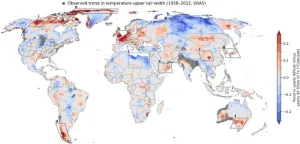(Press-News.org) Enron. Lehman Brothers. More recently, General Electric and Supermicro. During the past quarter century, a variety of high-profile companies have been caught cooking their books.
But they’re often not caught before they’ve cost investors billions of dollars. That’s why analysts have long tried to sniff out businesses that may be using questionable or flat-out illegal accounting tricks to hide poor performance.
New research from Urooj Khan, accounting professor and the Deloitte & Touche Centennial Faculty Fellow at Texas McCombs, proposes a new and more effective way to gauge companies’ “earnings quality.”
In analyses of corporate financial statements, Khan’s measure, known as earnings quality score (EQSCORE), proved superior to the best existing models at identifying companies engaged in possible accounting misconduct.
That’s because EQSCORE is more comprehensive, Khan says. It looks at a broader set of accounting red flags. It also considers issues with board governance — such as having an “insider” board chair who may be less impartial — and other problems uncovered by financial auditors.
“The motivation for this study was to bridge the gap between Wall Street’s approach to the discovery of earnings quality and its implementation in academia,” says Khan.
“This led us down the path of building a more comprehensive model of earnings quality. It encompasses a more wide-ranging view of the drivers of firm performance and determinants of financial reports.”
Flags for Fraud
To develop the model, Khan, with Venkat Peddireddy of China Europe International Business School and Shiva Rajgopal of Columbia University, scrutinized in-depth reports from a top private research firm. The reports, based on a wide variety of publicly available information, spotlighted specific companies engaged in possibly illegal or dubious financial reporting.
The researchers analyzed 613 reports to identify the metrics or “signals” the firm used to root out 230 companies. The vast majority were accounting-related, such as questionable revenue figures and profit margins. But they also included corporate governance and audit-related concerns.
Khan and his co-authors identified 51 red flags from the reports to serve as the basis for EQSCORE. Of those, 31 are accounting variables, eight are related to board characteristics, and 11 are audit-related variables.
To test EQSCORE against other models, the researchers applied it to another dataset of corporate bad actors: companies targeted by Securities and Exchange Commission enforcement actions.
Although the SEC sample doesn’t identify every case of suspect corporate accounting, it tends to catch the most blatant, Khan says. “Given its limited budget, the SEC selects cases with strong evidence of manipulation to bring an enforcement action.”
The researchers built EQSCORE using companies subjected to SEC enforcement from 2004 to 2009. They then assessed its power to predict a sample of companies that were subsequently charged by the SEC, from 2010 to 2016.
Compared with other scoring systems, theirs:
Correctly predicted 71% of the companies’ accounting years investigated by the SEC. The second-place model was correct for only 55% of suspect years.
Missed only 29% of years flagged by the SEC, compared with 45% for the next-best model.
Khan hopes that EQSCORE might pique the interest of the SEC, which began developing its own proprietary model in 2012 to detect fraud and accounting irregularities. It might also help private investors identify companies that are pushing legal accounting boundaries without clearly crossing them.
To demonstrate their tool’s potential for investors, the researchers built a stock market strategy around it. They simulated buying companies with low EQSCOREs and shorting those with high ones — placing bets that high-scored stocks would fall. The result for a seven-year period: average annual returns 7.8% higher than expected without the strategy.
Overall, Khan says, “We show that our EQSCORE improves upon existing approaches for predicting fraud. It’s useful for identifying firms that use aggressive accounting choices to misrepresent their true state, when their underlying business is deteriorating.”
“Earnings Quality on the Street” is published in Contemporary Accounting Research.
END
To catch financial rats, a better mousetrap
New tool helps reveal companies that might be using accounting tricks to cover up problems
2024-11-26
ELSE PRESS RELEASES FROM THIS DATE:
Mapping the world's climate danger zones
2024-11-26
With 2024 on track to be declared the hottest on record, scientists from IIASA and Columbia University have noticed that specific regions are consistently more affected by extreme temperatures. A new study provides the first worldwide map of these regional climate danger zones.
Amid the continued upward march in average temperatures over the past decades, a recent surge of record shattering extreme heat waves raise questions about the degree to which climate models can provide adequate estimates of relations between global mean temperature changes and regional climate risks. The study just published in the Proceedings of the National Academy of Sciences (PNAS) provides the ...
Emory heart team implants new blood-pumping device for first time in U.S.
2024-11-26
On Nov. 18, the heart failure and transplantation team at Emory University Hospital (EUH) made history, performing the first-ever surgical implantation in the United States of a brand-new type of ventricular assist device (VAD), which provides crucial care to patients with failing hearts.
An expert team led by veteran cardiothoracic surgeon Mani Daneshmand, MD, successfully implanted a novel magnetically levitated pump, a VAD that has been specifically designed for patient ease and long-term health. The BrioVAD System, made by BrioHealth Solutions Inc., was authorized by the FDA to begin clinical trials ...
Congenital heart defects caused by problems with placenta
2024-11-26
Congenital heart defects are the most common form of human birth defect, but we still don’t fully understand what causes them. Previous research had suggested that some heart defects could be triggered by problems with the placenta, the organ that provides oxygen and nutrients to the developing embryo. Now, researchers at Nanjing University, China have confirmed this link by focusing on a protein whose levels are reduced in many patients with congenital heart defects, called SLC25A1. SLC25A1 plays a key role in transporting ...
Schlechter named Cancer Moonshot Scholar
2024-11-26
Chelsey Schlechter, MPH, PhD, Huntsman Cancer Institute investigator and assistant professor in the Department of Population Health Sciences at the University of Utah (the U), has been selected as a Cancer Moonshot Scholar.
Schlechter is one of only eleven researchers in the U.S. chosen for the prestigious program this year, which aims to both advance impactful cancer research and broaden the research workforce.
For the project, Schlechter and her team partnered with the Association for Utah Community Health and Utah Community Health Centers—organizations which ...
Two-way water transfers can ensure reliability, save money for urban and agricultural users during drought in Western U.S., new study shows
2024-11-26
A new study led by researchers at the University of North Carolina at Chapel Hill offers a solution to water scarcity during droughts amid the tug of economic development, population growth and climate uncertainty for water users in Western U.S. states. The proposed two-way leasing contracts would coordinate agricultural-to-urban leasing during periods of drought and urban-to-agricultural leasing during wet periods, benefiting both urban and agricultural water users.
“Water markets are an important tool for allocating water in the Western U.S., and other water-scarce regions around the world, but they are often slow to respond to drought, ...
New issue of advances in dental research explores the role of women in dental, clinical, and translational research
2024-11-26
Alexandria, VA, USA - The Journal of Dental Research (JDR) has announced the publication of a new issue of Advances in Dental Research, a supplement to the Journal of Dental Research (JDR), entitled, "Women in Dental, Clinical, and Translational Research.”
The 2024 Annual Meeting of the American Association for Dental, Oral, and Craniofacial Research (AADOCR) and the Canadian Association for Dental Research featured a two-day “Meeting Within a Meeting” on the topic of “Women in Dental, Clinical, and Translational Research” organized by AADOCR Then- President Alexandre Vieira. During these sessions, speakers were challenged to reflect on ...
Team unlocks new insights on pulsar signals
2024-11-26
Team Unlocks New Insights on Pulsar Signals
November 26, 2024, Mountain View, CA – Dr. Sofia Sheikh from the SETI Institute led a study that sheds new light on how pulsar signals—the spinning remnants of massive stars—distort as they travel through space. This study, published in The Astrophysical Journal, was performed by a multi-year cohort of undergraduate researchers in the Penn State branch of the Pulsar Search Collaboratory student club. Maura McLaughlin, Chair, Eberly Distinguished Professor of Physics and Astronomy, West Virginia University, created the Pulsar Search Collaboratory to engage ...
Great apes visually track subject-object relationships like humans do
2024-11-26
Great apes track events with their eyes in the same way that humans do, according to a study published November 26th in the open-access journal PLOS Biology by Vanessa Wilson from the University of Neuchatel, Switzerland, and colleagues.
When watching a cat chase a mouse, humans will alternate looking at cat and mouse, using the information to connect the two into what’s called an agent-patient relationship—with the cat as the agent and the mouse as the patient. This cognitive mechanism is thought to be ...
Recovery of testing for heart disease risk factors post-COVID remains patchy
2024-11-26
Routine screening to detect risk factors for heart disease dropped sharply during the COVID-19 pandemic in England, and some key measurements, such as blood pressure readings, may still lag behind pre-pandemic levels. These findings are reported in a new study by Frederick Ho and Naveed Sattar of the University of Glasgow, Scotland, UK, and colleagues published November 26th in the open-access journal PLOS Medicine.
During the COVID-19 pandemic, patients went without routine face-to-face health checks, which are important for detecting common cardiometabolic ...
Final data and undiscovered images from NASA’s NEOWISE
2024-11-26
While NASA’s NEOWISE telescope ended its journey through space on Nov. 1, 2024, the team at IPAC, a science center at Caltech, was working on one further gift from the prolific mission.
The final data release from NEOWISE was released to the astronomy community just two weeks later, on Nov. 14, encompassing over 26 million images and nearly 200 billion sources detected by the telescope. And today, IPAC is releasing six new images from the mission’s archival data as a tribute to this landmark project, available here: https://www.astropix.org/link/3b2x
NEOWISE ...
LAST 30 PRESS RELEASES:
Ticking time bomb: Some farmers report as many as 70 tick encounters over a 6-month period
Turning garden and crop waste into plastics
Scientists discover ‘platypus galaxies’ in the early universe
Seeing thyroid cancer in a new light: when AI meets label-free imaging in the operating room
Neutrophil-to-lymphocyte ratio may aid risk stratification in depressive disorder
2026 Seismological Society of America Annual Meeting
AI-powered ECG analysis offers promising path for early detection of chronic obstructive pulmonary disease, says Mount Sinai researchers
GIMM uncovers flaws in lab-grown heart cells and paves the way for improved treatments
Cracking the evolutionary code of sleep
Medications could help the aging brain cope with surgery, memory impairment
Back pain linked to worse sleep years later in men over 65, according to study
CDC urges ‘shared decision-making’ on some childhood vaccines; many unclear about what that means
New research finds that an ‘equal treatment’ approach to economic opportunity advertising can backfire
Researchers create shape-shifting, self-navigating microparticles
Science army mobilizes to map US soil microbiome
Researchers develop new tools to turn grain crops into biosensors
Do supervised consumption sites bring increased crime? Study suggests that’s a myth
New mass spec innovation could transform research
Maternal nativity, race, and ethnicity and infant mortality in the US
Migration-related trauma among asylum seekers exposed to the migrant protection protocols
Jupiter’s moon Europa has a seafloor that may be quiet and lifeless
SwRI upgrades nuclear magnetic resonance laboratory for pharmaceutical R&D
House sparrows in northern Norway can help us save other endangered animals
Crohn's & Colitis Foundation survey reveals more than 1/3 of young adults with IBD face step therapy insurance barriers
Tethered UAV autonomous knotting on environmental structures for transport
Decentralized social media platforms unlock authentic consumer feedback
American Pediatric Society announces Vanderbilt University School of Medicine as host institution for APS Howland Visiting Professor Program
Scientists discover first method to safely back up quantum information
A role for orange pigments in birds and human redheads
Pathways to net-zero greenhouse gas emissions for Southeast Asia
[Press-News.org] To catch financial rats, a better mousetrapNew tool helps reveal companies that might be using accounting tricks to cover up problems





